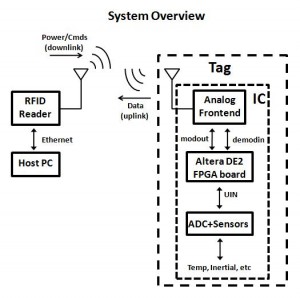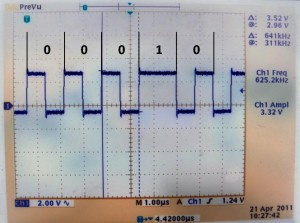Passive EPC Class 1 Gen 2 UHF RFID Sensor Tag for Health Monitoring Applications
- Category: Circuits & Systems
- Tags: Haobo Dong, Joel Dawson
This project aims to develop a device to monitor tremor for treatment of neurological disorders such as Parkinson’s disease (PD). PD is the third most common chronic disease of elderly people [1] . Currently, PD evaluation is mostly done qualitatively using the unified Parkinson’s disease rating scale or the Hoehn & Yahr scale [2] . Such evaluation is subjective to the doctors’ experience and impressions. Current approach makes it difficult to accurately monitor the disease’s progression, evaluate the efficacy of the drugs used for treatment, or determine whether deep brain stimulation has been effective. A long-term continuous tremor monitoring device that can collect movement data to assist quantitative analysis proves to be useful and needed.
Figure 1 shows the overview of the reader tag communication system. The initial tag prototype consists of the analog frontend, an Altera FPGA board, and the ADC sensor circuitry. The analog frontend includes a LC matching network, 5-stage voltage multiplier, demodulator, and the backscatter modulator. The FPGA board implements control logic that conforms to the industry EPC Class 1 Gen 2 RFID communication standard at 902-928 MHz. The ADC sensor circuitry includes an 8-bit ADC and an inertial sensor that collects x, y, and z axial data. Data is transmitted through ASK backscatter modulation, encoded in an FM0 or Miller modulated subcarrier, to the commercial RFID reader. The reader is connected to the host PC, where application software receives and processes the data.
Figure 2 shows the baseband backscattered data encoded in FM0 on a digital oscilloscope. Data 0 consists of a high and low phase whereas data 1 is the entire high phase. The maximum transmitted data rate, as shown in the figure, is around 640 Kbps. The system can achieve a read range up to 3 meters. [3]
- Figure 1: Overview of the reader tag communication system.
- Figure 2: Backscattered data encoded in FM0 captured on a digital oscilloscope.
- M. Manto, M. Topping, M. Soede, J. Sanchez-Lacuesta, W. Harwin, J. Pons, J. Williams, S. Skaarup, and L. Normie, “Dynamically responsive intervention for tremor suppression,” Engineering in Medicine and Biology Magazine, IEEE, vol. 22, pp. 120-132, 2003. [↩]
- G. Rigas, A. T. Tzallas, D. G. Tsalikakis, S. Konitsiotis, and D. I. Fotiadis, “Real-time quantification of resting tremor in the Parkinson’s disease,” in Engineering in Medicine and Biology Society, 2009. EMBC 2009. Annual International Conference of the IEEE, 2009, pp. 1306-1309. [↩]
- U. Karthaus and M. Fischer, “Fully integrated passive UHF RFID transponder IC with 16.7-µW minimum RF input power,” IEEE Journal of Solid-State Circuits, vol. 38, no. 10, pp. 1602- 1608, Oct. 2003. [↩]

